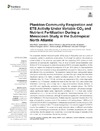Please use this identifier to cite or link to this item:
https://accedacris.ulpgc.es/jspui/handle/10553/42261
| Title: | Plankton community respiration and ETS activity under variable CO2 and nutrient fertilization during a mesocosm study in the subtropical North Atlantic | Authors: | Filella, Alba Baños, Isabel Montero, María F. Hernández-Hernández, Nauzet Rodríguez-Santos, Adriana Ludwig, Andrea Riebesell, Ulf Arístegui, Javier |
UNESCO Clasification: | 251001 Oceanografía biológica | Keywords: | Plankton respiration ETS activity R/ETS Ocean acidification Nutrient fertilization, et al |
Issue Date: | 2018 | Project: | Flujos de Carbono en Un Sistema de Afloramiento Costero (Cabo Blanco, Nw de Africa). Papel Del Carbono Disuelto y en Suspension en El Contexto de la Bomba Biologica. | Journal: | Frontiers in Marine Science | Abstract: | The enzymatic electron transport system (ETS) assay is frequently used as a proxy of respiratory activity in planktonic communities. It is thought to estimate the maximum overall activity of the enzymes associated with the respiratory ETS systems in both eukaryotic and prokaryotic organisms. Thus, in order to derive actual respiration rates (R) from ETS it is necessary to determine empirical R/ETS conversion algorithms. In this study we explore the temporal development of R and ETS activity in natural plankton communities (from bacteria to large phytoplankton) enclosed in mesocosms, treated with different CO2concentrations. The experiment lasted 30 days, during which abrupt changes in community structure and biomass occurred through a sharp transition from oligotrophy (phase I) to highly eutrophic conditions (phase II) after nutrient-induced fertilization (day 18). R and ETS did not show any response to CO2under oligotrophic conditions, but R increased significantly more in the two high CO2mesocosms after fertilization, coinciding with a sharp rise in large phytoplankton (mostly diatoms). R and ETS were significantly correlated only during the eutrophic phase. The R/ETS ranged more than threefold in magnitude during the experiment, with phase-averaged values significantly higher under oligotrophic conditions (0.7-1.1) than after nutrient fertilization (0.5-0.7). We did not find any significant relationship between R/ETS and community structure or biomass, although R correlated significantly with total biomass after fertilization in the four mesocosms. Multiple stepwise regression models show that large phytoplankton explains most of the variance in R during phases I (86%) and II (53%) and of ETS (86%) during phase II, while picophytoplankton contributes up to 73% to explain the variance in the ETS model during phase I. Our results suggest that R/ETS may be too variable in the ocean as to apply constant values to different communities living under contrasting environmental conditions. Controlled experiments with natural communities, like the present one, would help to constrain the range of variability of the R/ETS ratio, and to understand the factors driving it. | URI: | https://accedacris.ulpgc.es/handle/10553/42261 | ISSN: | 2296-7745 | DOI: | 10.3389/fmars.2018.00310 | Source: | Frontiers in Marine Science [ISSN 2296-7745], v. 5, article number 310 |
| Appears in Collections: | Artículos |
Items in accedaCRIS are protected by copyright, with all rights reserved, unless otherwise indicated.
